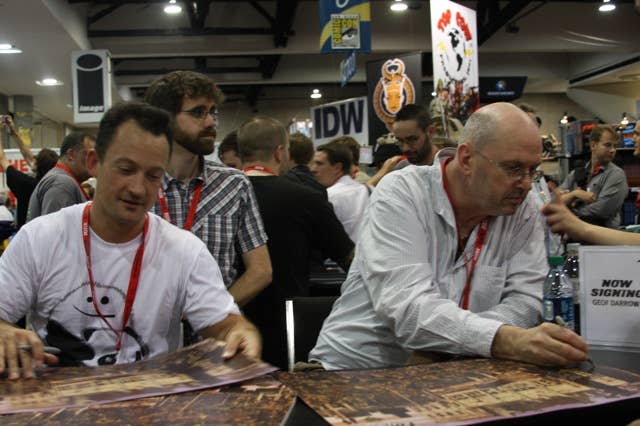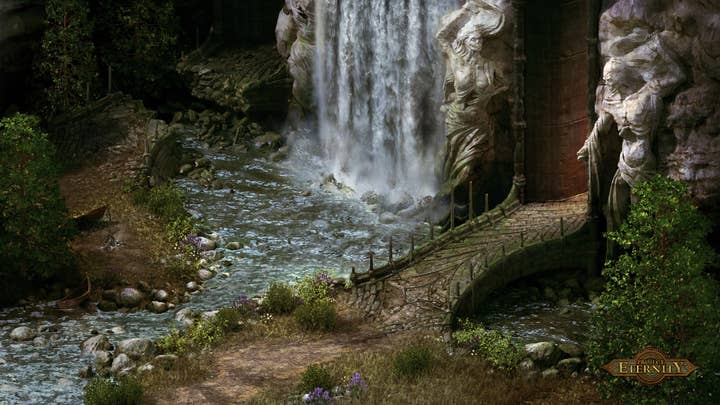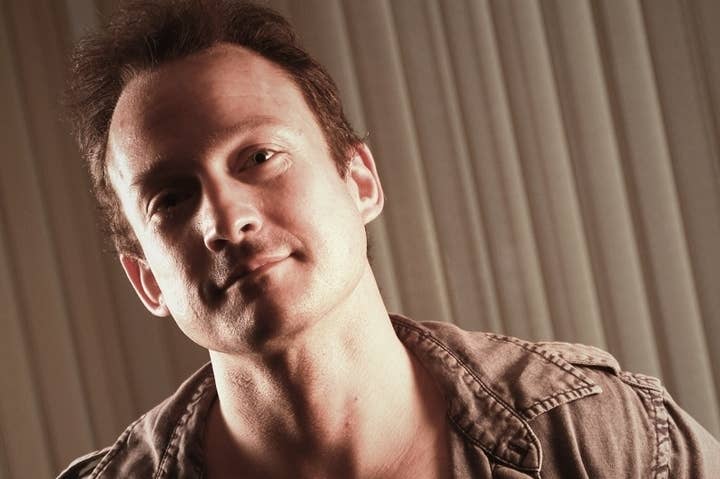Talking Shop: Obsidian Entertainment's Creative Director
We chat with industry vet Chris Avellone about being a great creative director
Every Wednesday and Friday, GamesIndustry International sits down with another member of the industry to talk about what they do. Today, we're talking to Obsidian Entertainment creative director Chris Avellone. Over the course of his 16-year career, Avellone has contributed to a number of classic titles, including Fallout 2, Planescape: Torment, Icewind Dale, Star Wars: Knights of the Old Republic II, Neverwinter Nights II, and Fallout: New Vegas. He's filled a number of positions with the word "designer" in the title: creative designer, lead designer, senior designer, narrative designer, and level designer. In 2003, he co-founded Obsidian Entertainment, where he currently holds the position of creative director.
When most people think of a creative director, they picture the singular auteur behind a game's overall vision. Creative directors can frequently have their names become synonymous with the projects they work on. Examples include Ken Levine's BioShock Infinite, Warren Spector's Deus Ex, and American McGee's Alice, the latter of which actually included the creative director's name in the official title. Avellone holds the title of creative director, but he said that at Obsidian his title means something slightly different.
"I suspect that what Levine and Spector do is more akin to what a project director at Obsidian does; they're the visionary responsible for the guiding of a project and everyone else on the team looks to them to set the tone and the goals of the project. Since we have multiple projects going on at once, having someone dedicated to each rather than overseeing both is ideal," he explained. "In my role as a creative director at Obsidian, my goal is to help project directors, designers, and other studio owners design and make 'fun' better at the company. I give advice and critiques when I can to help the process."
"While I have been directly involved on projects at Obsidian, with the possible exception of most of the Fallout New Vegas DLCs, I've never been a project director. It's a little complicated, as I have taken the lead designer, creative lead, narrative designer - and more recently with Wasteland 2 - area designer roles on projects and have developed content for those, that's more to help projects on an individual basis and to remain familiar with what's transpiring in the trenches in terms of editors and game development's nuts and bolts."
Avellone said his work at Obsidian differs from an executive producer who is "more focused on tasking, scheduling, and the production staff in general." In his creative position, Avellone answers to Obsidian's executive producers.

"As much as I provide advice and guidance to designers, executive producers do much the same thing except with a great focus on logistics, budget, and tasking timelines. They also coordinate pipelines across the company with the production staff and are more involved with producer hiring and staffing," Avellone said. "At Obsidian, I answer to our executive producer, often filtering design thoughts on the projects through production to make sure it meshes with their direction. We don't have game directors, although at points in the past the executive producer has been the project director. South Park, Alpha Protocol, and Knights of the Old Republic II are examples of that."
When asked about his average day, Avellone explained that he doesn't have what could be called an "average day." His position provides him with a great deal of flexibility and various responsibilities, so Avellone bounces from task to task.
"One day you're writing pitches, one day you're reviewing them. On another day you're writing dialogue, or you're critiquing it, or you're playing through the build and writing up bugs. The next day you might be helping conduct and lay out focus tests so others can do the same. It's always in flux. My favorite moments are when work calms down for a while - usually after hours and during the weekends - and I can sit down, get into a character's head, and script some dialogue or a scene I've had on the unconscious backburner for a while," he said.
Avellone has three tools that he finds indispensable to his work. The first is the combination of Microsoft Word and Microsoft Outlook, a tool Avellone said is one of "boring necessity." Together, he uses the Office products to correspond with others within Obsidian, critique design tests and documents, and write pitch documents. The second tool is his sketchbook, which goes everywhere he goes.
"I love my sketchbook," said Avellone. "If things are quiet and I don't feel like reading, then I'll just sit down and start drawing, usually stick figures. If beer is present, then stick figures are more likely to result. I did most of the RPG Codex stick figures for the Wasteland 2 Kickstarter while sitting in a dive bar on the beach a block away from inXile, and I was able to do a whole bunch beyond the requested number due to the... helpful power of alcohol."
Oddly enough, Avellone's "most important tool" is his Amazon Kindle.

"Not a lot of people know this, but I take a lot of game design notes while reading, and I like having access to a device where I can highlight passages, mark fragments of text that sound like cool spells or NPCs, or even electronically scribble down ideas for plots, quests, or inventory items. Like most writers and designers, I have hundreds of pages of idea fragments that I organize by category," he said.
"Being able to electronically scribe these through my Kindle and then download and sort them is a must. In the 'old' days, I used to do this manually by just highlighting books in my library while reading them, which pretty much guaranteed none of my friends would ever lend me books out of fear that I might accidentally mark them up."
Even as a project director on a title, Avellone stressed that game development is always about collaboration. In fact, he said that one of the highpoints of his career was due to the "collaborative experience." Avellone said learning when to allow your team to have freedom to explore ideas is key to being a creative director.
"One of the highpoints of my career in terms of fun and raw creativity was Fallout New Vegas: Old World Blues; it was a pure collaborative experience of everyone on the team, including the publisher and our contractors. Our voiceover company Blindlight and our Bethesda producer, Jason Bergman, helped us line up a cast that was perfect for the title, and that helped us sell the tone of the game perfectly. Never have I felt more joy in hearing the words, 'hey, we might be able to get James Urbaniak for Old World Blues.'"
"Trying to do everything yourself will drive you insane and likely do permanent damage to your health."
"If someone came to me and said they had an idea for a game that featured a plumber as a protagonist, or a man that dressed up like a bat to fight crime and whose arch-enemy was a clown, I could either roll my eyes and shoot it down or take the next step, ask for concept art reinforcing the idea, and ask more questions," he explained. "After being a designer for 20 years - you take a step back and say, 'even if this isn't how I would do it, would the player still like it, and does the concept depend more on execution than a one sentence idea?'"
"All it takes is imagining myself in their place, and imagine what I would have liked to have the freedom to express if I were in their shoes. While I may give cautionary tales and point out things that need to be prioritized or downscaled more, I'd like to think more of what I contribute is solutions to narrative problems or design pipeline issues, but I'm not the best judge of that," added Avellone.
Avellone believes the most important part of being a creative director is "taking in the big picture." He prefers to shepherd his team towards finding great execution in their own ideas, instead of driving his own vision forward by doing everything himself.
"I don't like being the 'no' guy, I'd prefer to be the 'yes, and...' guy. I believe a lot of good game ideas are in the execution, not the original premise," he said. "Being aware of execution and trusting your designers to execute properly, and if not, trying to guide them towards reaching their ideas. Reminding them of priorities and what's important versus trying to do everything all at once, or worse, trying to do everything yourself. It only took one project 14 years ago to cure me of both. Planescape: Torment was my first lead designer role where it sunk in that trying to do everything yourself will drive you insane and likely do permanent damage to your health."

Avellone admits that as a co-founder at Obsidian, "the creative burden is nowhere close to the actual company survival burden." Getting more development contracts keeps the studio open and puts food on the table. The stress of keeping developers employed means going over successful and failed projects to see what the company did right or wrong.
"When it comes to creativity and design, we've hired a lot of people that excel in that department. Your stress comes in what you can fight to allow them to make," Avellone stated. "You have a lot of influence over what games your studio gets, its budget, and the franchise. You have to fight every day to secure a new contract and keep the momentum going... and even when you have a contract, you still have to fight every day to keep it moving strongly."
"It's incredibly stressful, and it is for all owners and leads. Every pitch you do, every milestone that gets delivered, every publisher or backer interaction - other people's careers rely on you, and you're making sure you can provide for them. It's as if you have a family of a hundred people, and it's your job to feed them all. There's been too many times where a project cancellation occurs and you do repeated mental and physical post-mortems to see how you could have prevented it, if at all."
Avellone did not have any formal training when he joined the industry long ago. Though he did go to college, his degree is in English, with a minor in Fine Arts. His RPG experience kicked off early as a game master for a pen-and-paper games like Dungeons & Dragons, Champions, and Superworld. Avellone admits that led into his later work and said aspiring designers need to "do the job before you get the job."
"The best designers I've ever known are the ones that are or would still be designers even if they didn't have a career in the industry."
"I didn't have any formal training beyond GM-ing for a ruthless, lazy bunch of players who would rarely ever run their own games and couldn't be bothered to even fully give their own characters disadvantages when balancing them. When you do that for a random bunch of personalities over a 10 year period across a number of game systems, you make a lot of mistakes, and that helps guide you as an entertainer," he said.
"Get familiar with all the tools out there - play games, not just ones you like, but as many as you can, and do post-mortems for each one. Get to know people at the companies where you want to work, ask them advice, ask them to help critique your design or art portfolio, or simply be friendly. If they ignore you or are jerks, then you wouldn't want to work with them anyway. Do mods. Put them up on the net. Let the internet savage them, then revise them, patch them, and put them back up there for another round of critiques. The best designers I've ever known are the ones that are or would still be designers even if they didn't have a career in the industry; I sure would, and many of the developers at Obsidian are the same way."
Those looking to get into the industry can take a look at GamesIndustry International's Jobs Board.

